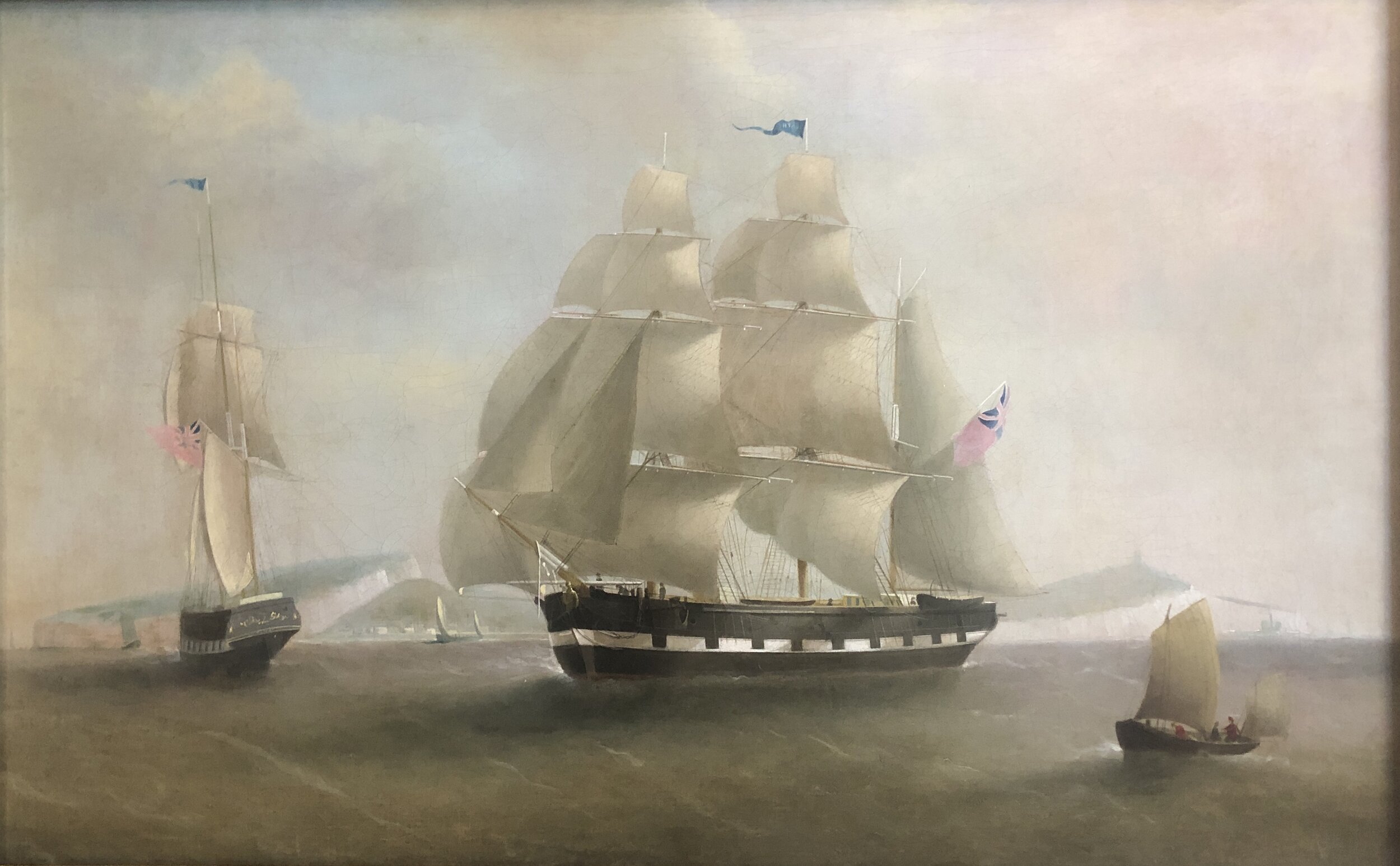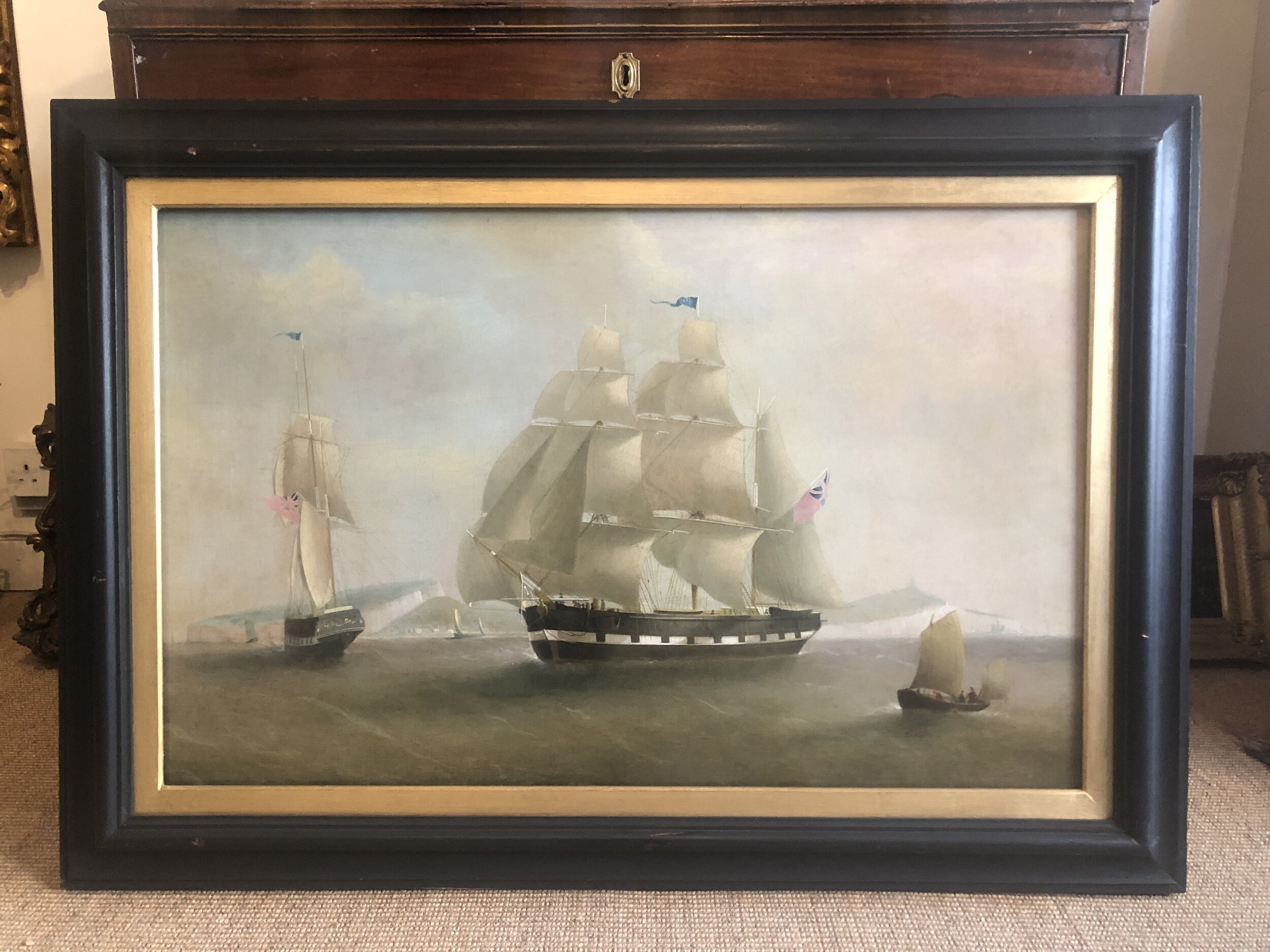William John Huggins (1781-1845, English)
A Ship in Two Positions Off Dover
oil on canvas
33 x 45 inches, inc. frame
Price: £11,000
William John Huggins, of whose parents nothing is known, reputedly began life as a sailor in the East India Company, but his only known voyage was from December 1812 to August 1814, to Bombay and China, when he was listed for wages as ‘ordinary seaman’ while serving as steward to Captain Thomas Buchanan on the company ship Perseverance. Unless the ‘ordinary’ rating reflects the circumstance of a man no longer fit to do an able seaman's duty, he may never have been one, although he clearly knew his subject.
A painting of the frigate Phoenix (36 guns), under Captain W. H. Webley (later Webley-Parry), convoying seventeen ships including the Perseverance home from Madras in 1814, was reputed in the Webley-Parry family to have been his first picture, and they lent it to the Royal Naval Exhibition at Chelsea in 1891 (catalogue no. 566). By 1817, when Huggins first exhibited at the Royal Academy (at the British Institution from 1825), he had settled in London at 36 Leadenhall Street (no. 105 from 1823 or 1824), near East India House. Here he remained for the rest of his life, specializing in portraits of East India vessels for captains, owners, and others, and similar shipping and naval subjects, including in watercolours.
He appears to have had some early help from Thomas Duncan (c.1779–1841), a ship decorator, print colourist, and art teacher whose son, Edward Duncan (1803–1882), a member of the Old Watercolour Society, subsequently collaborated with him as a lithographer. Edward reproduced about 150 of Huggins's works, acquired skill as a marine painter from him, and in 1834 married his eldest daughter, Berthia (1809–1884). Huggins and Duncan also occasionally painted pictures together, such as one of Indiamen in the China Sea, now in the National Maritime Museum, Greenwich, which is signed by both.
Huggins's Eastern sketches provided authentic backgrounds to his work, although he is also likely to have used other people's. He was a competent ship portraitist with a distinctive smooth finish to his oils and rather silvery, muted colour, and his work provides an important record of the shipping of his time.
On 20 September 1830, Huggins was appointed marine painter to William IV (the ‘sailor king’), who according to Redgrave ‘esteemed his work rather for its correctness than its art’ and commissioned three large paintings of the battle of Trafalgar from him. The first two were shown publicly at Exeter Hall in 1834, the third at the British Institution in 1837: all remain in the Royal Collection.
His works still often appear in the market, fetching substantial prices from collectors, and there are twenty-six in the National Maritime Museum. This also holds drawings, watercolours, prints, and two ship portraits by James Miller Huggins (bap. 1807), who was his son and pupil; he exhibited at the Society of British Artists, 1826–30, once at the British Institution in 1842, and was still working in 1865. He and another son, John W. Huggins (bap. 1809), also etched a number of Huggins's shipping studies published between 1824 and 1833 (later gathered in bound form as ‘Huggins' Marine Sketches’, n.d.). Huggins died on 19 May 1845, aged sixty-four. A letter of 1951 in the National Maritime Museum, London, suggests family papers were carelessly destroyed.
Huggins and his wife, Berthia (a name also spelt Berthier), had three other daughters, Elizabeth Mary (bap. 1813), Amelia, later Gibbs (bap. 1817), and Sarah Christiana (bap. 1821). His will, dated 1841 and proved on 12 August 1845, made them his beneficiaries, appointing the last two and his widow as executors, with directions to ‘sell by public auction all my sketches drawings and paintings’, but retaining his stock of engraved plates to reissue for joint benefit. Neither his daughter Berthia nor his sons are mentioned.



